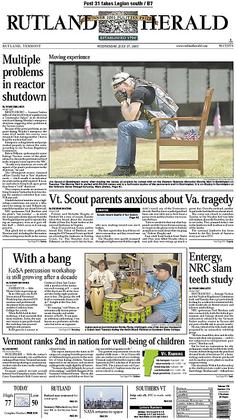Rutland Herald

The July 27, 2005 front page of the
Rutland Herald |
|
| Type | Daily newspaper |
|---|---|
| Format | Broadsheet |
| Owner(s) | Herald Association |
| Publisher | R. John Mitchell |
| Editor | Randal Smathers |
| Founded | 1794 |
| Headquarters | 27 Wales Street Rutland, VT 05702 United States |
| Circulation | 17,000 |
| Website | rutlandherald.com |
The Rutland Herald is the second largest daily newspaper in the U.S. state of Vermont (after the Burlington Free Press). It is published in Rutland. With a daily circulation of about 12,000, it is the main source of news geared towards the southern part of the state, along with the Brattleboro Reformer and the Bennington Banner. The Rutland Herald is the sister paper of the Barre Montpelier Times Argus. The Herald is the oldest family-owned newspaper in continuous operation, published under the same name in the same city, in the United States. Its seven eras of ownership, much simplified, are sketched below
I The Williams-Williams partnership, which launched the Herald as a weekly on December 8, 1794, was brief but among the most interesting. The Rev. Samuel Williams was a federalist with high journalistic standards, but his newspaper, as was true of most during these times, barely touched upon local news or state issues. Both Williamses are buried on North Main Street in Rutland in the same cemetery.
II The era of printer William Fay, 1797-1840, was somewhat unfocused during a time when all transportation and commerce depended upon the horse. The paper was largely devoted to biblical parables, fables, poems and homilies.
III George Beaman (1844 to 1856) provided welcome invigoration - for journalistic, political and technological reasons. He was a strong abolitionist who wanted to influence his Whig party (which soon became the Republican party) with anti-slavery sentiments. During his time the railroads arrived, ending rural isolation, providing a boom for commerce, industry and population. Due to Beaman's boosterism, the railroad was routed through Rutland and became its defining industry for the century to follow.
IV During the era of George and Albert Tuttle (father and son, 1856-1882), the Herald moved to daily publication when the Civil War began and provided some distinguished reportage on the war. The paper was weakened during postwar depressions and several competitors sprang up. In 1877 the major competitor, the Globe, and the Herald merged. Seeking new investors, Albert Tuttle netted the important P.W. Clement.
V Mixing business, politics and publishing was what Percival W. Clement was all about; he owned the Herald from 1882 to 1927. A Rutland native, Clement also owned Rutland Railroad, the Clement National Bank and New York real estate interests and a brokerage house. He blatantly used his newspaper to support his own projects and political aspirations. He had a strong rivalry with the strong Proctor family of the Vermont Marble Co. Clement held several political offices, and ran for governor three times before being elected in 1918 at the age of 73.
...
Wikipedia
